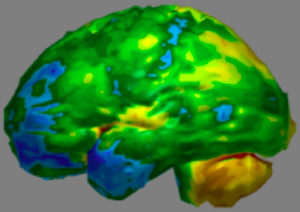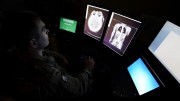LITTLETON, CO – Dr. Bruce Perry developed the Neurosequential Model of Therapeutics (NMT), a means of assessing the neurological development of a child, after decades of working with children who had been emotionally, physically, and sexually abused. But Dr. Perry had no way of verifying the NMT, which makes predictions about the growth of a child’s brain, until he partnered with the Littleton, Colorado-based brain imaging company CereScan.
“We provide data on brain functioning that helps inform diagnosis,” said Shane Quint, CereScan’s chief technology officer. “Patients often come to us with an incoming diagnosis, but they’re not getting better, and their doctor can’t figure out what’s wrong. Once they go through our process, most of the time they come out with a different diagnosis.”
CereScan’s process consists of an intake procedure, in which a patient’s complete medical history is taken, followed by a scan in one of the company’s medical imaging machines. By providing clinicians with a detailed view of a patient’s brain, CereScan’s imaging software helps to reduce misdiagnosis in the treatment of neurological disorders like Alzheimer’s, Parkinson’s, and PTSD.
(Read the CyberMed News profile of Cerescan here.)
Dr. Perry’s interest in the company centered on its database, CereMetrix, which contained brain scans from over 800 children, twenty of whom had undergone abuse of some kind during early childhood. By examining the histories of these twenty children using the NMT, and then comparing his findings to the scans stored in CereMetrix, Dr. Perry would be able to test the NMT’s capacity to predict each child’s state of neurological development.
“The human brain develops eighty percent of its size and shape in the first three years of life,” explained Quint. “First the brain stem develops, and then the cerebellum, and then the occipital lobe and the parietal lobe and the frontal lobe. Different areas of the brain are responsible for different functions, so if someone is abused during early childhood, it can affect the functioning of the areas of the brain that are developing at that time, which will show up as symptoms.”
In the field of child psychiatry, Dr. Perry’s NMT is used to interview children who have suffered abuse at a very young age. When specific incidents or periods of trauma are identified, the NMT employs a contemporary understanding of neurological development to predict which areas of the child’s brain might have been affected. After these areas have been identified, the NMT can be used to develop a treatment plan tailored to meet that child’s developmental needs.
During its collaboration with Dr. Perry, CereScan analyzed the scans in CereMetrix, examining the rate of blood flow in the brains of the twenty children who had been selected for the study. (When specific areas of the brain aren’t functioning properly, blood flow in those areas will often be either too low or too high.) While CereScan analyzed the children’s scans, Dr. Perry studied their medical histories, using the information they contained to apply the NMT to each child.
“Of the twenty children in our database, we could only use fifteen,” admitted Quint. “It’s a small sample, so you can’t look at this as a major research piece. But in the children Dr. Perry identified as having a potential deficiency in the cerebellum, we found evidence of low blood flow in that area.”
While the initial results of the study were promising, further examination revealed that the NMT might be too broad in its assessment of certain regions of the brain.
“Dr. Perry’s NMT scoring had identified issues in the limbic system for several of the children, but when we averaged the ten areas of the brain that make up the limbic system, the blood profusion levels looked normal. So we started digging deeper into the data, and found specific areas of the limbic system – the amygdala, for example – that were hyper-profused, which is something that you wouldn’t find normally.”
Alongside Dr. T. Richard Fort, CereScan’s chief science officer, Quint and Dr. Perry recently presented their findings at the Second International Neurosequential Model Symposium in Banff, Canada. The positive response they received at the conference raised the possibility of future collaborations between Dr. Perry and CereScan.
“I think we can help Dr. Perry do a better job of diagnosing and identifying the effectiveness of his treatment protocols, which will have a major impact on children who have trauma in their early developmental stages,” Quint explained. “Right now, he’s having a big impact on his own. But if we can help him do a better job of diagnosing the areas of the brain affected by early childhood abuse, then he’ll be able to do a better job of finding out how to correct those problems.”
Like the coverage that CyberMed News provides? Follow us on Twitter, LinkedIn, and Facebook to make sure you keep up to date on the most recent developments in digital health.






Quite informative and enlightening, and it gives great hope for future infants/children of our nations who so unfortunately encounter such abuse. Thank you Dr. Perry and CereScan.
Would this same concept work as well in evaluating adult individuals who may be suffering the early effects of CTE? Am thinking of both those who have served in the military and law enforcement as well as youth to adult sports?
From my conversations with John Kelley, the CEO of Cerescan, I know his company is working with a range of individuals, from former NFL players to teenagers and veterans. While it appears that the NMT was only used during Cerescan’s collaboration with Dr. Perry, the company’s work with Tim Kumrie, a former NFL player and coach who I quoted in my profile on Cerescan, seems to suggest a general approach that is very similar to Dr. Perry’s: identify areas of the brain that might have been affected by trauma or disease, and then prescribe treatments that have been shown to improve functioning in those areas.